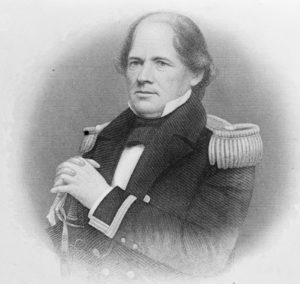
Matthew Maury (1806 – 1873) was an American Naval officer and oceanographer. He is credited with the moniker “Father of Modern Oceanography” thanks to the comprehensive book on oceanography he published in 1855, The Physical Geography of the Sea.
Maury was born into a Huguenot family in Virginia but had moved to Tennessee by the time he turned five. His brother John was a Navy officer and Matthew was determined to follow suit. He obtained a naval appointment at age 19 from Tennessee Representative Sam Houston. He immediately began studying the sea on a four-year voyage aboard the Vincennes that began in 1826. It was the first US Naval warship to circumnavigate the globe. Sadly, his seafaring days came to an abrupt end at the age of 33 after his leg was maimed in a stagecoach accident. Henceforth he would devote his time to studying the ocean.
In 1842 Maury was placed as head of the Depot of Charts and Instruments in Washington DC, which offered him a tremendous amount of maritime data in terms of log books and various other records. He would eventually turn this institution into the United States Naval Observatory and become its first superintendent.
In 1855 he published the first modern oceanography textbook, The Physical Geography of the Sea, describing the winds, currents, climate, and physical geography over the worlds oceans. That same year Maury proposed sea lanes in his book Sailing Directions. This idea was taken up by the major shipping companies to the benefit of lives and dollars saved. He also sent out survey ships to take depth readings on the Atlantic Ocean’s floor, which revealed the Mid-Atlantic ridge. His books and his surveys helped to prove the feasibility of laying a first transatlantic cable, which occurred in July 1866.
The American Civil War interrupted his career, sending him to Europe and then to Mexico before he finally returned to Virginia where he took the post of professor of meteorology at the Virginia Military Institute. He stayed there until his death in 1873.